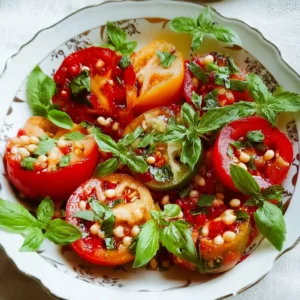Fresh tomatoes are a summer treasure, bursting with flavor, nutrients, and vibrant color. Whether you’re growing them in your backyard or buying them from the local farmer’s market, fresh tomatoes are an essential ingredient in many of your favorite dishes. In this article, we’ll explore the best fresh tomato recipes, from homemade sauces to light salads, all designed to highlight the natural sweetness of ripe tomatoes.
What Are Fresh Tomatoes?
Fresh tomatoes are typically harvested during the summer and early fall, when they are at their peak ripeness. Unlike their canned counterparts, fresh tomatoes retain their full, juicy flavor and bright color, making them a favorite ingredient in countless recipes.
Common Types of Fresh Tomatoes:
• Beefsteak Tomatoes – These large, meaty tomatoes are perfect for slicing, making them ideal for sandwiches and burgers.
• Roma Tomatoes – Known for their dense flesh and low moisture content, Roma tomatoes are great for making sauces and pastes.
• Cherry Tomatoes – These small, round tomatoes are sweet and juicy, making them a popular choice for salads and snacking.
• Heirloom Tomatoes – Available in a variety of colors, heirloom tomatoes have a rich flavor and are excellent in fresh salads or sliced on their own.

Fresh Tomato Sauce: A Simple, Delicious Recipe
One of the best ways to enjoy fresh tomatoes is by making a homemade tomato sauce. This sauce is versatile and can be used on pasta, pizza, or as a base for other dishes. Here’s a recipe that showcases the fresh, bright flavors of tomatoes.
Ingredients for Fresh Tomato Sauce
• 3 pounds of medium on-the-vine tomatoes – Fresh, in-season tomatoes are the star of the show here.
• 2 tablespoons of extra-virgin olive oil – For richness and depth.
• 1/3 cup of finely minced shallot or onion – Adds a mild sweetness and savory flavor.
• 2 large garlic cloves, finely minced – Garlic brings a fragrant aroma to the sauce.
• 1 tablespoon of tomato paste – Intensifies the tomato flavor and helps thicken the sauce.
• 2 teaspoons of balsamic vinegar – Adds a touch of acidity that balances the sweetness of the tomatoes.
• 1/4 teaspoon of cane sugar – A subtle sweetness to balance the tang of the tomatoes and vinegar.
• 1/4 teaspoon of dried oregano – A classic herb that pairs well with tomatoes.
• 1/4 teaspoon of red pepper flakes – For a hint of heat.
• Salt and freshly ground black pepper – To taste.
• 1 sprig of fresh basil – Adds freshness and fragrance.
Instructions
-
Prepare the Tomatoes:
Begin by slicing the tomatoes in half and scooping out the seeds. Use a box grater to grate the cut side of each tomato half into a large bowl. The flesh will fall through, while the skins remain behind. This method gives you a smooth texture while removing the skins. -
Sauté the Aromatics:
Heat the olive oil in a medium saucepan over low heat. Add the finely minced shallot and garlic, and cook for about 3 minutes, stirring occasionally, until softened and fragrant. -
Simmer the Sauce:
Add the grated tomatoes, tomato paste, balsamic vinegar, sugar, oregano, and red pepper flakes to the pot. Stir to combine, then cover and simmer over low heat for 30 minutes, stirring occasionally. The sauce will thicken and deepen in flavor. -
Final Touches:
Once the sauce has reached the desired thickness, remove and discard the basil sprig. Taste and adjust the seasoning with more salt, pepper, or sugar if needed.
Serving Suggestions
This fresh tomato sauce is incredibly versatile and can be used in many ways beyond just pasta. Here are a few ideas to get you started:
• As a Pasta Sauce: Toss the fresh tomato sauce with your favorite pasta shape for a classic, flavorful dish.
• On Pizza: Use the sauce as a base for homemade pizza, topped with fresh mozzarella and basil.
• Over Polenta: Spoon the sauce over creamy polenta for a hearty side dish.
• On Zucchini Noodles: A perfect low-carb alternative to pasta, zucchini noodles pair beautifully with this fresh sauce.
• In a Meatball Sub: For a quick, satisfying meal, serve the sauce in a baguette with your favorite meatballs.

Fresh Tomato Salad: A Refreshing and Healthy Option
If you’re looking for something light and healthy, a fresh tomato salad is the perfect option. This recipe takes advantage of the natural sweetness and juiciness of fresh tomatoes, combined with other vibrant ingredients to create a refreshing dish. It’s perfect as a side or even a main dish during warm weather.
Ingredients for Fresh Tomato Salad
• 4 large ripe tomatoes – Choose firm, but juicy tomatoes for the best flavor.
• 1 cucumber, diced – Adds a crisp texture that complements the tomatoes.
• 1/2 red onion, thinly sliced – Provides a mild sharpness to balance the sweetness of the tomatoes.
• 1/4 cup of fresh parsley, chopped – For a burst of freshness.
• 2 tablespoons of extra-virgin olive oil – Adds richness to the salad.
• 1 tablespoon of red wine vinegar – Brings a tangy contrast to the sweetness of the tomatoes.
• Salt and pepper to taste – Enhances all the flavors.
• Optional: Feta cheese, crumbled – Adds a creamy, salty element to the salad.
Instructions
-
Prepare the Vegetables:
Slice the tomatoes into wedges or cubes, depending on your preference. Dice the cucumber and thinly slice the red onion. -
Toss the Salad:
In a large mixing bowl, combine the tomatoes, cucumber, red onion, and parsley. Gently toss to combine. -
Dress the Salad:
Drizzle the olive oil and red wine vinegar over the salad. Season with salt and pepper to taste. If you’re adding feta, sprinkle it on top. -
Chill and Serve:
For best results, let the salad sit in the fridge for about 15 minutes to allow the flavors to meld together before serving.
Variations of Fresh Tomato Salad
While this salad is delicious as-is, you can experiment with other ingredients to suit your taste. Here are a few variations:
• Avocado: Add diced avocado for a creamy element that pairs perfectly with the tomatoes.
• Olives: Kalamata or green olives add a briny, savory twist.
• Basil: Fresh basil leaves can replace parsley for an herbaceous flavor.
Health Benefits of Fresh Tomatoes
Tomatoes aren’t just delicious—they’re packed with essential nutrients that can benefit your health. Here are a few reasons why you should include fresh tomatoes in your diet:
• Rich in Antioxidants: Tomatoes are a great source of lycopene, a powerful antioxidant that may help protect against certain types of cancer and heart disease.
• High in Vitamin C: Tomatoes are rich in vitamin C, which supports immune health and skin health.
• Low in Calories: Fresh tomatoes are low in calories, making them a perfect choice for weight management.
• Good Source of Fiber: Tomatoes provide dietary fiber, which is essential for healthy digestion.

Fresh Tomato Soup: A Comforting Dish for Any Time of Year
Tomato soup is a classic comfort food that’s loved by many. When made with fresh tomatoes, it takes on a whole new level of flavor. This fresh tomato soup is light yet comforting, with a rich and velvety texture. It’s perfect for chilly evenings or as a starter for a hearty meal.
Ingredients for Fresh Tomato Soup
• 4 large ripe tomatoes – Choose sweet, juicy tomatoes for the best taste.
• 1 tablespoon of olive oil – For sautéing the onions and garlic.
• 1 small onion, finely chopped – Adds a mild sweetness to the soup base.
• 2 garlic cloves, minced – For a burst of aromatic flavor.
• 2 cups vegetable or chicken broth – Adds depth and richness to the soup.
• 1/4 teaspoon of dried thyme – Enhances the savory notes of the soup.
• 1/4 teaspoon of sugar – Balances the acidity of the tomatoes.
• Salt and freshly ground black pepper – To taste.
• 1/4 cup of heavy cream (optional) – For a creamy, smooth texture.
• Fresh basil leaves (optional) – For garnish and added flavor.
Instructions
-
Prepare the Tomatoes:
Blanch the tomatoes by making small X-shaped cuts on the bottom, then placing them in boiling water for 1-2 minutes. Transfer them to an ice bath to cool. Peel the skins off, remove the seeds, and roughly chop the tomatoes. -
Sauté the Aromatics:
Heat olive oil in a large pot over medium heat. Add the chopped onion and garlic, cooking until they are soft and fragrant, about 5 minutes. -
Simmer the Soup:
Add the chopped tomatoes to the pot, followed by the broth, thyme, sugar, salt, and pepper. Stir everything together, and bring the soup to a simmer. Cook for 20-25 minutes, stirring occasionally, until the tomatoes are fully softened. -
Blend the Soup:
Use an immersion blender to puree the soup until smooth. If you don’t have an immersion blender, you can carefully transfer the soup to a blender in batches. -
Finish the Soup:
For a creamy version, stir in the heavy cream and simmer for an additional 5 minutes. Taste and adjust seasoning if necessary. -
Serve:
Ladle the soup into bowls and garnish with fresh basil leaves. Serve hot with crusty bread or a grilled cheese sandwich for the ultimate comfort meal.
Variations of Fresh Tomato Soup
While the classic version is always a winner, here are a few variations you can try:
• Spicy Tomato Soup: Add a pinch of red pepper flakes or a diced jalapeño to the soup for some heat.
• Roasted Tomato Soup: Roast the tomatoes in the oven for 20 minutes before adding them to the soup for a smoky, caramelized flavor.
• Tomato and Basil Soup: For a more herbaceous flavor, add extra fresh basil during the blending stage.
Storing and Freezing Fresh Tomato Soup
If you have leftovers or want to make a big batch in advance, you can store the soup in the fridge or freezer:
• In the fridge: Let the soup cool to room temperature, then transfer it to an airtight container. It will keep for up to 3-4 days in the refrigerator.
• In the freezer: Allow the soup to cool completely, then transfer it to freezer-safe containers or bags. It can be stored in the freezer for up to 3 months. To reheat, simply thaw and warm on the stove.

Conclusion on Fresh Tomato Recipes
Fresh tomatoes are a versatile and delicious ingredient that can be used in a wide range of recipes, from sauces and soups to salads and salsas. Whether you’re making a classic fresh tomato sauce, a vibrant salad, or a comforting soup, these recipes highlight the best of what fresh tomatoes have to offer. They’re perfect for every meal, bringing both flavor and nutrition to your plate.
By incorporating fresh tomatoes into your cooking, you’re not only enhancing the taste of your dishes but also boosting their health benefits. So, the next time you have a bounty of fresh tomatoes, try one of these recipes and savor the taste of summer all year round.
Fresh Tomato Sauce Recipe Card
A simple and flavorful sauce made with fresh tomatoes, perfect for pasta, pizza, and more. The bright and sweet taste of ripe tomatoes shines through, creating a sauce that’s both versatile and delicious.
Ingredients
-
3 pounds of medium on-the-vine tomatoes
-
2 tablespoons extra-virgin olive oil
-
1/3 cup finely minced shallot or onion
-
2 large garlic cloves, finely minced
-
1 tablespoon tomato paste
-
2 teaspoons balsamic vinegar
-
1/4 teaspoon cane sugar
-
1/4 teaspoon dried oregano
-
1/4 teaspoon red pepper flakes
-
Salt and freshly ground black pepper, to taste
-
1 sprig fresh basil
Instructions
-
Prepare the tomatoes: Slice the tomatoes in half and scoop out the seeds. Grate the cut side of each tomato half using a box grater into a bowl, leaving the skins behind.
-
Sauté the aromatics: Heat olive oil in a medium saucepan over low heat. Add the minced shallot and garlic, and cook for about 3 minutes until softened.
-
Simmer the sauce: Add the grated tomatoes, tomato paste, balsamic vinegar, sugar, oregano, and red pepper flakes. Stir well, cover, and simmer on low for 30 minutes.
-
Adjust seasoning: Taste and adjust seasoning with salt, pepper, or sugar if needed. Discard the basil sprig before serving.
Notes
-
You can store leftover sauce in an airtight container for up to 4 days in the fridge or freeze it for up to 3 months.
-
This sauce is great for pasta, pizza, or as a dip for bread.
Nutritional Facts (per serving)
-
Calories: 80
-
Fat: 5g
-
Carbohydrates: 10g
-
Fiber: 2g
-
Sugars: 6g
-
Protein: 2g
Prep Time: 20 minutes
Cook Time: 30 minutes
Total Time: 50 minutes
Method: Stovetop
Cuisine: Italian
Servings: 4
Yield: 2 cups



